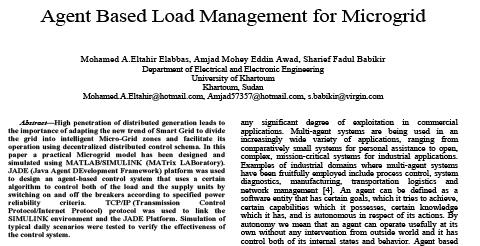The increasing demand on the power grid makes the dependency on large central generation units infeasible due to the cost and the losses in the transmission lines. Given the challenges facing the grid of today. distributed generation (DG) has been widely seen as an opportunity to facilitate the planning. management and security of the distribution network [1]. The Micro Grid (MG) concept assumes a cluster of loads and micro-sources operating as a single controllable system that provides both power and heat to its local area. This concept provides a new paradigm for defining the operation of distributed generation [2]. MG is a localized grouping of distributed energy resources (DER) and controllable interconnected load all connected to the grid through single point of common coupling and can operate either connected to the grid (connected mode) or isolated from the grid (Islanded mode). The division of power grid to multiple MG will help to reduce the overall overhead of controlling the grid from central control unit and also each MG can contribute in reducing the peak demand by shifting or even satisfying its load with the local generation which help in reducing the cost of running the central generation in its spinning reserve limit [3]. Agent technology has been the subject of extensive discussion and investigation within the scientific community for several years. but it is perhaps only recently that it has seen any significant degree of exploitation in commercial applications. Multi-agent systems are being used in an increasingly wide variety of applications. ranging from comparatively small systems for personal assistance to open. complex. mission-critical systems for industrial applications. Examples of industrial domains where multi-agent systems have been fruitfully employed include process control. system diagnostics. manufacturing. transportation logistics and network management [4]. An agent can be defined as a software entity that has certain goals. which it tries to achieve. certain capabilities which it possesses. certain knowledge which it has. and is autonomous in respect of its actions. By autonomy we mean that an agent can operate usefully at its own without any intervention from outside world and it has control both of its internal states and behavior. Agent based programming can be considered as a logical extension of programming methodologies and it can be viewed as a specialized form of an object where no one from outside world can change its state. or as a particular form of a component [5]. These days. intelligent agent based control is an effective way to monitor and control the system operations in different conditions [7]. In [8 and 9]. the author discussed the criteria of multi agent system in electrical power applications. The design and implementation of multi agent systems in Microgrid using JADE platform is being illustrated in [10]. An architecture of MAS using TCP IP is proposed in [11.12.13]. In this paper an agent is designed based on Java Agent Development Framework (JADE) to function as load operator who monitors the available generation and the needed demand to decide which load to turn off based on priority. The SIMULINK model represents the physical grid while JADE agent represents the control device that manage the demandsupply operation. The connection between these two parts is implemented via TCP IP communication protocol.

 Iran Energy News Oil, Gas, Petrochemical and Energy Field Specialized Channel
Iran Energy News Oil, Gas, Petrochemical and Energy Field Specialized Channel



